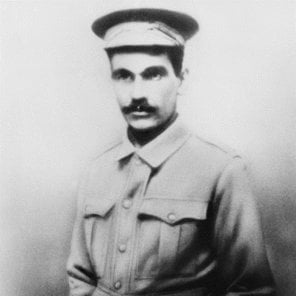
- Inducted:
- 2014
Henry 'Harry' Thorpe was a Brabuwooloong man of the Gunaikurnai nation and an accomplished infantryman who served in World War I. Awarded the Military Medal for his bravery, he was killed in battle on 9 August 1918, just 3 months before the war's end.
Life on the family farm
Born in 1886 at Lake Tyers Mission Station, Harry was the son of William Thorpe and Lilian (née Wilson), both of the Gunaikurnai nation. He lost his mother when he was only 3 years old and his father later married Sarah Dawson. The family lived on a 15-acre farm at Lakes Entrance, which was given to Harry's father on the recommendation of Reverend John Bulmer, the manager of Lake Tyers Mission. As a young man, Harry helped his father run the farm, growing crops and tending livestock.
Together, Harry and his father also secured contracts to dig graves, build fences and strip wattle bark for sale to local tanneries. They were respected members of the local community and admired for their work ethic. In his spare time, Harry trained as a hurdler and played football, both of which showcased his natural athleticism. In 1905, he married Julia Scott, who was from Ramahyuck Mission on the shores of Lake Wellington. Harry built them a house to live in on the farm and in 1906 the couple's son Reg was born.
Volunteered for the Australian Imperial Force
On 12 February 1916 Harry travelled to Sale on horseback and enlisted in the Australian Imperial Force. He was one of an estimated 800 to 1000 Aboriginal people who volunteered to enlist during World War I, despite being afforded very few rights in the country they fought for. Harry embarked from Melbourne in April with the 17th Reinforcements to the 7th Battalion, arriving on the Western Front in France in July 1916. His battalion encountered heavy fighting at Pozières and within 2 weeks Harry was evacuated with a gunshot wound to his leg.
After he recovered, Harry rejoined his unit and was promoted to lance corporal in early 1917. During the battle of Bullecourt in April that year, Harry was wounded in the shoulder, but returned to duty a month later. His injuries did not diminish his abilities as a footballer or as a scout, and within his unit he was noted for his skill at both.
Harry displayed tremendous courage and leadership
In October 1917, during operations to capture Broodseinde Ridge during the third battle of Ypres in Belgium, Harry displayed tremendous courage and leadership while clearing the dugouts and concrete guard posts, known as pillboxes, of remaining enemy resistance. He was promoted to corporal and awarded the Military Medal, although he was originally recommended for the Distinguished Conduct Medal. The military citation commended Harry's ""disregard of all danger"" and described him as an inspiration to his men.
The 7th Battalion went on to fight in the Flanders region until they were moved forward to join the great allied offensive at Somme in mid-1918. During an advance on 9 August 1918 at Lihons Wood, south-west of Vauvillers, Harry was wounded in the stomach. He was found by a stretcher-bearer and taken to a dressing station, but died shortly after. Harry was 34 years old and was buried at Heath cemetery in Harbonnières, France.
Today, the name Harry Thorpe is inscribed on the cenotaph in Lakes Entrance, where a street called Thorpe's Lane is also named in his honour. For his family, Harry's is a story of courage and sacrifice that transcends time and will never be forgotten.
Lest we forget.
Updated

